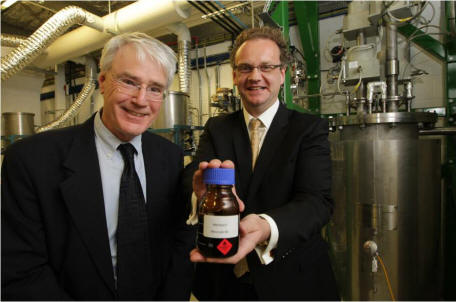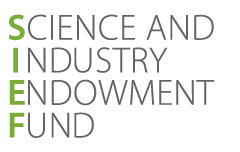Renewable Chemicals Research Project
Advanced Catalytic Processes for Renewable Chemicals Manufacture
Chemical Processing Stream
Due to carbon-constraint considerations (CO2/climate, limited supply of fossil resources), there is a world-wide push towards the sourcing of chemicals from renewables, particularly where this can be integrated into existing supply chains (no land use changes) and/or combined with waste treatment or recycling. The hydrothermal upgrading approach, that sits at the core of this project, allows for diverse biomass feedstocks such as woody waste or even macroalgae from waste-water treatment to be processed into higher value products, i.e. fuels, bulk chemicals, intermediates, fine and specialty chemicals. This technology has the potential to greatly invigorate the Australian agriculture, forestry and manufacturing industry sectors, linking them via innovative biorefinery technologies. They offer the potential for the development of sustainable chemicals that will open avenues to a new manufacturing paradigm.

Image: (Left to Right) Professors Brian Haynes and Thomas Maschmeyer
As an Australian first in an academic environment, a unique continuous flow pilot reactor was used to explore various biomass sources and their processing behaviour, nicely dove-tailing and complementing work by one of the commercial partners, Licella, which operates a demonstration-scale pilot plant at 10,000 tonnes per annum that is focused on waste from pulp & paper mills.
Deep scientific insights were gained in terms of processing parameters and their effect on product composition and quality by examining micro- as well as macroalga, grasses, wood as well as model compounds of carbohydrates derived from the biomass by investigating the kinetics of transformation for glucose and its dimer cellobiose. In a remarkable achievement we were able to develop a full predictive model of the reactivity of these models, able to match experiment to within better than 90%.
Furthermore, we extended these models to include the shorter sugar dihydroxyacetone (DHA) – a potential key building block for bio-derived chemicals as well as to the aromatics from the lignin fraction of the biomass by developing experimentally validated kinetic models for vanillin isomerisations.
We designed, developed and showcased a full path from macroalgae (that were used for waste-water remediation) to fully fungible fuel products (derived from the process’ biocrude product). These fungible fuels were produced via a novel two-step hydro-treating process that was developed in this project using a Ni2P/SiO2 in combination with a Pt/zeolite catalyst. A significant advance in biocrude upgrading.
Furthermore, chemicals from the aqueous phase were identified that can be used in the production of resins and as sources for fuel additives and solvents. Within this context, a ‘green’ alkylation of such aromatics using the organic base DBU to produce aromatic ethers, useable as solvents and fuel additives (uplifting ‘normal’ to ‘super’ petrol) has been developed and patented.
Great progress was made by upgrading Kraft lignin liquors to produce highly aromatic biocrudes that are blendstocks for resin production, which are currently being evaluated by the CSIRO/Licella, showing excellent properties.
Enzymatic Processing Stream
Both biocatalysis and continuous flow chemistry have had major impacts on the way that we approach chemical synthesis, especially in the fine chemicals and pharmaceuticals industries. Biocatalysis employs enzymes to catalyse chemical transformations, capitalising on their inherent high catalytic rates and high specificities and capacity to operate under low pressure and temperature conditions. Continuous flow chemistry allows chemical reactions to run in a continuously flowing stream rather than in a batch reactor; complex multistep reactors can be assembled by arranging reactors in series and/or parallel with each reactor housing a unique reaction. Both technologies offer substantial advantages, many of which ought to provide synergistic benefits.
Although enzymes have been use in flow reactors, they have been limited to cofactor independent enzymes. Cofactors, such as nicotinamide adenine dinucleotide (NAD) and adenosine triphosphate (ATP), are diffusible small molecules that participate in enzymatic reactions. These cofactors can be used only once in a reaction unless recycled, typically by a second enzyme; without cofactor recycling many biocatalytic processes would be uneconomical. Because cofactors are not only diffusible, but require diffusion for recycling via a second enzyme, they are ill-suited for use in continuous flow reactors.
In addition to the provision and recycling of cofactors, it is essential to provide a mechanism to efficiently spatially organise the components of reactions on a solid support in such a way that they can function fully despite the continued requirement for diffusion in cofactor recycling. Current immobilisation technologies rely on non-specific cross linking; this often leads to high levels of enzyme inactivation and lacks the degree of precision required for the fabrication of a cofactor-dependent, biocatalytic flow reactor.
We selected a target organic synthesis to demonstrate the broad utility of the design principles developed in the project. Sugar analogues, such as the aminocyclitols, are high profile pharmaceutical compounds containing multiple stereocentres. We have used our prototype reactor to produce aminocylitols enzymatically from an inexpensive and abundant starting material (glycerol). The enzymatic cascade requires three enzymes for the synthesis of the sugar analogues and two enzymes for the regeneration of the cofactors. Therefore, as a model system, the production of sugar analogues addresses all of the major hurdles associated with the production of a multi-step, enzymatic flow cell and has enabled us to establish design principles for the construction of such devices.
We have produced a prototype multi-step, enzymatic flow reactor, combining the advantages of flow chemistry (scalability, rapid reaction times, fine control of reaction sequence etc.) with those of biocatalysis (high chemo-, region- and stereospecificity, low temperature/pressure, low waste, high atom economy etc.). The device itself is modular, hierarchical organization of components that provides a flexible, combinatorial platform for chemical synthesis. This is the first time that such a device has been demonstrated. We anticipate that flow reactors based on the enabling technology developed in this project will be adopted by the fine chemicals and pharmaceuticals industry, enabling new manufacturing processes that reduce cost and improve their environmental profiles.
For further information please contact:
Project Leader: Prof. Thomas Maschmeyer, The University of Sydney, thomas.maschmeyer@sydney.edu.au
Chemical Stream: Prof. Brian Haynes, The University of Sydney, brian.haynes@sydney.edu.au
Enzymatic Stream: Dr. Greg Simpson, CSIRO, Greg.Simpson@csiro.au
Related links
